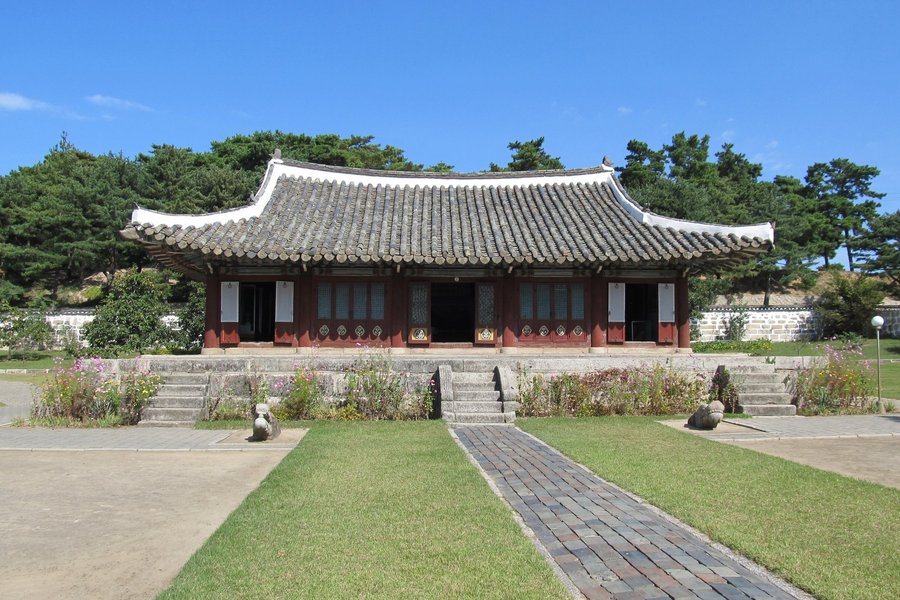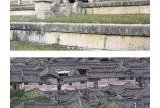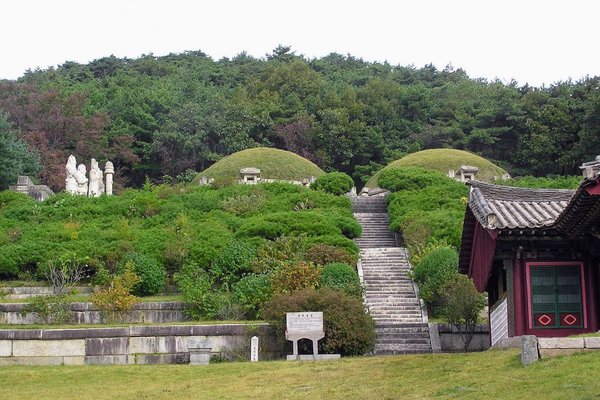Korea (DPR)
Kaesong
The Historic Monuments and Sites in Kaesong represent the capital of the Koryo dynasty with its associated tombs and set of beliefs.
The Koryo (918-1392) unified Korea and during their reign, Buddhism was replaced by Confucianism as the main religion. Kaesong was developed in a geomantic setting, using the surrounding mountain tops as markers. The designated area covers 12 remaining Koryo monuments and sites, including parts of the city walls, former educational institutions, memorial sites and mausolea.
Community Perspective: Kaesong usually features on the itineraries of the standard guided tours of North Korea, but which parts you get to see is a matter of luck. Solivagant was led to King Kongmin’s Tomb and had some views of old-looking buildings from afar. AC went to Sonjuk Bridge, the Namdaemum, the Koryo Museum and the tomb of King Wang Gon.
Site Info
Official Information
- Full Name
- Historic Monuments and Sites in Kaesong (ID: 1278)
- Country
- Korea (DPR)
- Status
-
Inscribed 2013
Site history
History of Kaesong
- 2013: Inscribed
- Inscribed
- 2012: Incomplete - not examined
- 2008: Deferred
- Reconsider sites to hold significant and representative examples of the Koryo Dynasty
- Type
- Cultural
- Criteria
- ii
- iii
Links
- UNESCO
- whc.unesco.org
All Links
UNESCO.org
- whc.unesco.org — whc.unesco.org/
News Article
- Sept. 12, 2018 english.yonhapnews.co.kr — Koreas to restart joint excavation of historic palace site in Kaesong
Community Information
- Community Category
- Urban landscape: Asian
Travel Information
Guided Tour Only
Recent Connections
-
Confucian Academy (Shuyuan, Seowon, Shijuku)
Sungyangseowon
-
Goryeo
Criterion (iii): The Historic Monument…
-
Poetic Quotations
Transition from Goryeo to Joseon "Even…
Connections of Kaesong
- Individual People
-
-
Isabella Bird
Chapter 25 Songdo: A Royal City (Descriptions and sketches of Kaesong City Walls and Manwoldae Palace ruins) "There is a fine bronze bell with curiously involved dragons in one of the gate towers, cast five centuries ago... Outside the crowd and bustle of the city, reached by a narrow path among prosperous ginseng farms and persimmon-embowered hamlets, are the lonely remains of the Kings who reigned in Korea prior to the dynasty of which the present sovereign is the representative, and even in their forlornness they give the impression that the Korean kings were much statelier monarchs than they are now... The palace platform is intersected by massive stone foundations of halls and rooms, some of large area." Isabella Bird "Korea and Her Neighbors (pg. 292-300) -
Homer B. Hulbert
"Just outside the wall of Songdo (Kaesong), the ancient capital of Koryu (Goryeo), is shown a small stone bridge in which the loyal Chong Mong-ju was slain. He was faithful to the closing dynasty, and had to be put out of the way before the new one could be firmly established. On the central stone of this bridge is seen today a great brown blotch, which turns to a dull red in the rain, and the Koreans affirm it is the blood of that loyal man." - Homer Hulbert - "The Passing of Korea" pg. 292
-
- Trivia
-
-
Dragon
Phyochung Monuments - "The monuments comprise large turtle-shaped granite plinths weighing over ten tons, supporting black marble stelae inscribed with poems commemorating Jong Mong Ju, and topped by pavilion-style hipped-gable caps carved from granite with dragon reliefs." - nomination file
-
- History
-
-
Located in a Former Capital
capital of Korea during the Koryo Dynasty -
Goryeo
Criterion (iii): The Historic Monuments and Sites in Kaesong are exceptional testimony to the unified Koryo civilisation as Buddhism gave way to neo-Confucianism in East Asia.
-
Assassinations
At Sonjuk Bridge famed Confucian scholar and statesman Jeong, Mong-ju was murdered for his refusal to betray the Goryeo Dynasty. His death marks the end of the Goryeo Dynasty, and the emergence of Joseon. - wiki & nomination file -
Mongol Invasions
"A large part of Manwoldae was damaged in the days when the capital was moved to Kanghwa Island between 1232 and 1270 during a Mongol invasion." - Nomination File
-
- Architecture
-
-
Wooden architecture
"The Kaesong Namdae Gate was built as the main south gate, one of five gates in the Inner Wall, in 1393, and is the oldest of all the long-standing gates on the Korean Peninsula. The upper section is a single-storey wooden pavilion three bays long by two bays wide with a hipped gable roof." - AB Evaluation -
Geomancy
"Construction on the palace began in 919, at the beginning of the Goryeo dynasty; it was built south of the Songak mountains for good feng shui." - wiki / "The integration of Buddhist, Confucian, Taoist and geomantic concepts is manifest in the planning of the site and the architecture of its monuments" (UNESCO)
-
- Damaged
-
-
Damaged in War since WWII
Korean War "After the country's liberation in 1945, US troops attempted to bulldoze the back site of the central group of buildings to build military barracks there, but had to suspend the project owing to the local people's protest. During the Korean War (1950-1953), the stoneworks in the front part of the central group of buildings were damaged by bombing. After the war, the local people and the Korean People's Army soldiers reconstructed the damaged part over two years, between 1953 and 1954. Afterwards, Manwoldae was registered as a National Treasure Site." (Nom file) and "In 1950 the pavilion above the Namdae Gate was burnt down during US bombing" (AV) -
Destroyed during invasion
"Koryo Songgyungwan was burnt down by Japanese invaders in 1592; rebuilt over nine years from 1602." - nomination file
-
- Religion and Belief
-
-
Taoism
The integration of Buddhist, Confucian, Taoist and geomantic concepts is manifest (Unesco) -
Confucianism
The integration of Buddhist, Confucian, Taoist and geomantic concepts is manifest (Unesco)
-
- Human Activity
-
-
LGBTQ culture
Mausoleum of King Gongmin - "King Gongmin (1325–1374) of Goryeo is on record as having kept several wonchung ("male lovers") in his court as “little-brother attendants” (chajewhi) who served as sexual partners. After the death of his wife, King Gongmin even went so far as to create a ministry whose sole purpose was to seek out and recruit young men from all over the country to serve in his court."See en.wikipedia.org
-
- Constructions
-
-
Tombs
associated Seven Tombs Cluster and Myongrung Tombs Cluster -
Famous Bells
Yonbuk Bell, housed in Namdae Gate are both National Treasures of the DPRK "The gate houses the Yŏnbok Bell cast in 1346 and weighing 14 tonnes. Recovered from Yŏnbok Temple when it was destroyed by fire in 1563, the bell was used to call out the hours until the early 20th century." wiki -
Dynastic Burial Places
Goryeo Dynasty -
Mausolea
Mausoleum of King Wang Kon, Mausoleum of King Kongmin -
Notable Bridges
Sonjuk Bridge (built in 1290, location of infamous assassination) -
Bixi
Phyochung Monuments - "The monuments comprise large turtle-shaped granite plinths weighing over ten tons, supporting black marble stelae inscribed with poems commemorating Jong Mong Ju, and topped by pavilion-style hipped-gable caps carved from granite with dragon reliefs." - nomination file -
Stelae
commemorative steles
-
- Timeline
-
-
Built in the 10th century
ruling base of the Koryo dynasty (918-1392)
-
- Science and Technology
-
-
Universities
Koryo Songgyungwan University -
Confucian Academy (Shuyuan, Seowon, Shijuku)
Sungyangseowon
-
Astronomy and Astrology
The monuments inscribed also include an astronomical and meteorological observatory
-
- Visiting conditions
-
-
Guided Tour Only
A visit anywhere in North Korea is guided
-
- Literature & Film
-
-
Poetic Quotations
Transition from Goryeo to Joseon "Even if I may die, die a hundred times, Even if my skeleton may become dust and dirt, And whether my spirit may be there or not, My single-hearted loyalty to my lord will not change." - Assassination of Jong Mong-ju at Sonjuk Bridge 1392, signaling the end of the Goryeo Dynasty
-
News
- english.yonhapnews.co.kr 09/12/2018
- Koreas to restart joint excavation…
Recent Visitors
Visitors of Kaesong
- AC
- Adrian Turtschi
- A. Mehmet Haksever
- Ammon Watkins
- Atila Ege
- basementonline
- Bram de Bruin
- Christian Wagner
- Christravelblog
- Erik Jelinek
- Fan Yibo
- finsbury_jo
- Garrett
- Harry Mitsidis
- jxrocky
- Knut
- Leonie Geurts
- Loic Pedras
- Luis Filipe Gaspar
- MarcoB_0
- Marcobrey
- Mikko
- Nihal Ege
- Palimpsesto
- Philipp Leu
- Pieter Dijkshoorn
- Sergio Arjona
- SnakeGreen
- Solivagant
- Szucs Tamas
- Tamara Ratz
- Tcchang0825
- Thomas Buechler
- Vernon Prieto
- wantrain.
- wolfboy
- Zoë Sheng
Community Reviews
Show full reviews
We were taken on a whirlwind tour of Kaesong city. Within less than two hours we got to see the Sonjuk Bridge, the Namdaemum, the Koryo Museum and the tomb of King Wang Gon. Most visitors I think get to see the museum. The bridge was thrown in because we had lunch at the nearby restaurant (which I discovered to my surprise was within the core zone) and some of us asked to see it. That particular tomb was chosen instead Kongmin's, I cannot help but suspect, because Wang Gon was the founder of the Koryo and credited with unifying the Korean nation. And we drove by the Namdaemun twice, when entering and leaving the city.
We found out that the tomb of Wang Gon could be entered at a lovely price of 100 euros per person.
I am not quite sure what to think of what I had seen. There was hardly any time to absorb anything and the guides were bent on ensuring that we could get back to Pyongyang in time that same day to see the birthplace of the eternal chairman. But I guess I should be grateful that I even got to see four sites.
Keep reading 0 comments
A row of tourist faces looked out over the locked gate of their hotel compound in Kaesong. Beyond it North Koreans passed by, walking or cycling their way to work – but their gaze was fixedly averted away from the tourists. A policeman "directed" the non existent motor traffic. On the other side of the T junction the rows of attractive stone houses with low tiled roofs receded into the distance. But all thought of communication with the locals or wandering along those streets was useless – we were “imprisoned” in our hotel as this was tourism North Korean style!
But, if you go to DPRK you just have to accept these restrictions, you may try to break or just stretch them but you probably don’t want to get your guide into trouble – ours was a lady who was certainly no party hack but just someone trying to make a living in this very strange society – naïve and propagandised yes but also intelligent, not “pushy” of the party line and generally very pleasant and “nice”.
I wonder how ICOMOS will view Kaesong’s application for inscription? I am still rather amused at the recommendation after its visit to the Koguryo Tombs which were inscribed in 2004 that a “Visitor’s Management Plan” should be produced. For goodness sake - visitors here are the most “managed” anywhere in the world!!!! No one (foreigners or locals) goes to see ANYTHING in an uncontrolled way! ICOMOS/UNESCO seemed prepared then to overlook even matters …
Keep reading 0 comments
